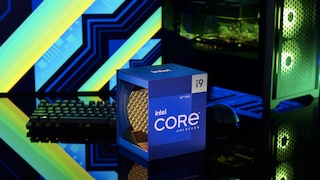Intel announces Alder Lake 12th Gen Core i9, i7, and i5 chips for desktops
Intel has announced the Alder Lake 12th Gen Core desktop processors. There are six models in the lineup, including the flagship Core i9-12900K CPU, which Intel calls the world’s best gaming processor. Intel’s Alder Lake architecture uses the 10nm fabrication process but what really stands out is the hybrid approach. These CPUs use both performance and efficiency cores to distribute the workload, giving an optimised performance - something that makes Intel closer to matching Arm-based chipsets.
There are three base models - Intel Core i9-12900K, Core i7-12700K, and Core i5-12600K - and the remaining three models come with the KF suffix at the end, where F denotes lack of an integrated Intel UHD Graphics 770 GPU. Intel’s new desktop chipsets also mark the launch of the DDR5 RAM and PCIe 5.0 standard for storage interconnection, meaning better data relay, and thus, better performance. While that is one of the reasons behind Intel’s claim that the top model in the line-up is the best gaming CPU in the world, a lot is riding on the new hybrid architecture.
Intel has thrown two core types into the mix for its Alder Lake CPUs. There are big, high-powered performance cores called P-cores and small, low-powered efficiency cores called E-cores. Together, they bring what Intel calls the “Performance Hybrid Architecture.” For instance, the Intel Core i9-12900K model has 8 P-cores and 8 E-cores, in a 16-core design.
Simply put, Intel’s new desktop processors will work the same way the processor inside your phone does. The same architecture is also what powers the Apple Silicon processor (M1, M1 Pro, and M1 Max). The idea is to offload the bulk of pressure to the P-cores when an app needs the maximum performance, but otherwise, low-level tasks and apps can be managed by the E-cores, which consume comparatively less power and ensure the processor’s longevity.
To give you an example, the CPU will use the P-cores when you are playing a high-end game such as Call of Duty: Warzone on your PC, but it will switch to E-cores when you are watching a movie or listening to music.
Intel has designed the CPU in a way that only the P-cores can use multithreading, while the E-cores deliver workloads based on single threads. That is also why there are three types of clock speeds for Intel’s new processors. There is a base clock speed, a boost clock speed, and a max clock speed. For example, the top-end Core i9-12900K model has a base speed of 3.2GHz, a boost speed of 5.1GHz, and a max speed of 5.2GHz, which comes only from the P-cores. The E-cores, on the other hand, have a 2.4GHz base clock speed and a 3.9GHz boost speed.
There is also more cache size available with the Alder Lake CPUs. The Core i9 has a 30MB L3 cache, the Core i7 can use a 25MB L3 cache, and the Core i5 gets a 20MB cache for L3 RAM. The new processors are radically different, which means they need a new chipset/motherboard design. Intel is calling it Z690 and it uses a new LGA1700 socket, which will make the design exclusive to Intel’s Alder Lake processors. There may be over 60 motherboard models expected from vendors when the new processors hit the market.
Intel’s new Alder Lake processors are priced as below:
Core i9-12900K: up to 3.2GHz P-core, 2.4GHz E-core, 5.2GHz boost - $589
Core i9-12900KF: up to 3.2GHz P-core, 2.4GHz E-core, 5.2GHz boost - $564
Core i7-12700K : up to 3.6GHz P-core, 2.7GHz E-core, 5.0GHz boost - $409
Core i7-12700KF: up to 3.6GHz P-core, 2.7GHz E-core, 5.0GHz boost - $384
Core i5-12600K: up to 3.7GHz P-core, 2.8GHz E-core, 4.9GHz boost - $289
Core i5-12600KF: up to 3.7GHz P-core, 2.8GHz E-core, 4.9GHz boost - $264





Post a Comment